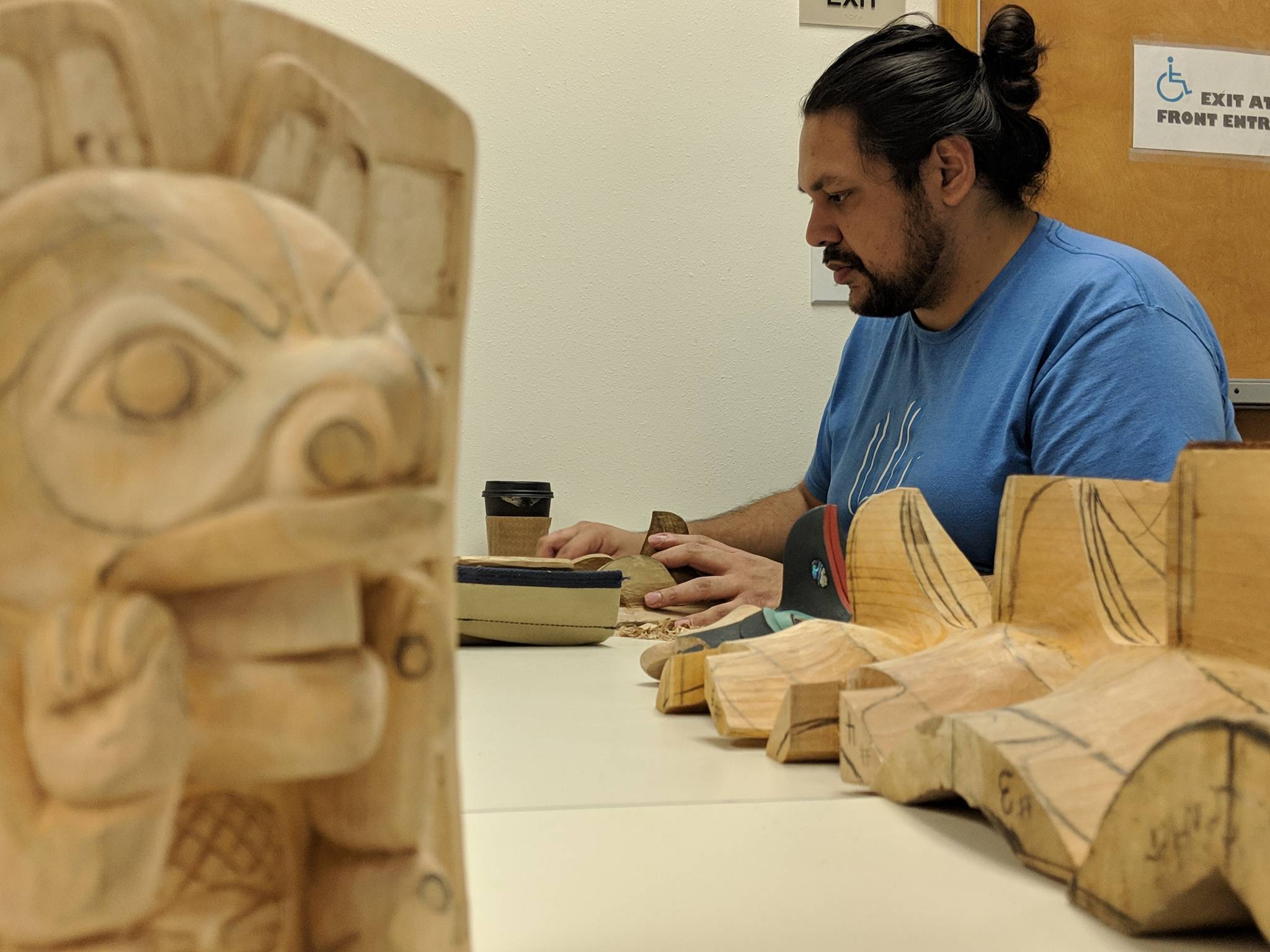Teaching is at the center of Saturday Carving Practice at Gajaa Hit.
It provides a network that allows someone like Henry Hopkins with a decade of experience carving in the Tlingit style to learn from artists such as Donald Gregory, Ray Watkins and Steve Brown, whose combined carving experience is close to 100 years.
“I’m just lucky to get to carve with these great carvers here,” Hopkins said. “I’ve been carving all of my life, but probably only the last 10 years of my life in the Tlingit traditions. It’s very challenging,” he added. “Formline doesn’t come naturally to those who didn’t grow up with it.”
[Master carver teaches art behind bars]
Hopkins, who teaches science and subsidence-tool making at Juneau-Douglas Yadaa.at Kalé High School, said he’s able to pass along what he gleans from the other carvers to his students.
The carving practices take place 1-6 p.m. on Saturdays and are offered through Sealaska Heritage Institute. They are free to registrants, who can apply online. Some wood and tools are also provided, but carvers are encouraged to bring their own materials.
Carvers said the gatherings are a valuable information exchange.
“We have Ray here, which really is such an amazing resource,” said Doug Gray, who has about 15 years of carving experience.
Watkins, who has taught carving for University of Alaska, Sealaska Heritage Institute and Goldbelt Heritage Foundation over the years, has been a particular instructive through-line in Gray’s evolution as a carver.
Gray said when he first came to Juneau 14 years ago, he had “really taken a break from culture,” but had been invited to join a dance group. He had all of his regalia ready to go, but did not have his headdress.
So Gray took a class with Watkins to make his own headdress.
“I’ve been carving with Ray ever since,” Gray said.
While the practices aren’t for novices, Gregory, who facilitates the practices, said they could help point beginners in the right direction.
“Especially getting them started out with where they can get some tools,” Gregory said.
The final frontier
Simply offering space for carvers to work is important, Gregory said.
“We’ve really seen that there’s a need for it,” Gregory said. “There’s no shop where you can sit down and carve that’s open to the public.”
The practices are first-come, first-serve.
[Tlingit elders talk metal carving and weaving]
Gregory said this is the second year the carving practices have been offered, and while some of the winter months are slow the shop tends to get crowded as word spreads.
“Before we finished the last round, it would be full in here,” Gregory said.
The space is important for the project Brown was working on Saturday. The wood wasn’t yet present, but the carver with 50 years of experience was setting up the tools that would allow him to soon begin working on a house post.
The post will be a collaboration with Tlingit artist Nathan Jackson, Brown said. Jackson will make a screen that will match the post.
Brown said he’s glad to work on it in a relatively public area.
“It’s available and an opportunity to share the process with people who are here, whether it’s as an apprenticeship or as an observation,” Brown said.
Frontlets, masks and more
This past Saturday, six carvers had their hands full with a variety of projects.
The shop was filled with the smell of friction-burned wood and the sounds of woodworking, a radio broadcast of a high school basketball game and shop talk.
[Master carver makes healing totem]
Gray worked on a lovebirds bowl and a couple of frontlets, Hopkins was in the early stages of a mask, Gregory was much further along on a mask of his own and Watkins worked on a frontlet that would serve as a model in his next teaching class.
While Gregory worked on his mask with a rotary tool, his nephew, Took Gregory, worked on a raven frontlet.
He said had worked on the healing totem erected in June at Savikko Park, but the piece he was working on was his first smaller carving project.
“I want to learn how to do everything Tlingit,” Took Gregory said.
That includes spoons, masks, bowls and paddles.
“So I can teach everyone, especially the younger generation,” he said. “Your uncle is supposed to teach you. Hopefully, my brother has kids, so I can teach them. It’s about keeping the culture going and growing.”
• Contact reporter Ben Hohenstatt at (907)523-2243 or bhohenstatt@juneauempire.com. Contact arts and culture reporter Ben Hohenstatt at (907)523-2243 or bhohenstatt@juneauempire.com.

